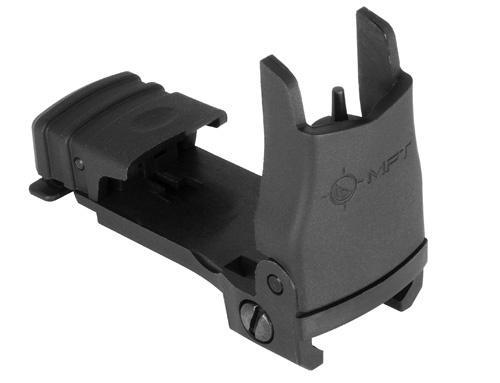

Mission First Front Back Up Polymer Sight provides reliable performance and precision adjustments for tactical shooters. Specifically designed to mount seamlessly onto a 1913 Picatinny rail, this sight offers a quick deployment flip-up feature, allowing for immediate access in fast-paced scenarios. Built from Military Grade reinforced polyamide, it withstands harsh conditions while maintaining a lightweight profile, making it ideal for outdoor competitions and low-light shooting situations.
This sight ensures clear targeting with its standard elevation adjustment feature, allowing for easy fine-tuning of your aim. With its robust construction and user-friendly design, the Mission First Front Back Up Polymer Sight is suitable for both seasoned marksmen and casual shooters. Its protective shroud keeps the front post blade safe from debris, enhancing durability and performance when it matters most.
Features:
- PREMIUM DURABILITY: Crafted from Military Grade reinforced polyamide, ensuring reliable performance under tough conditions.
- QUICK DEPLOYMENT: Flip-up design allows for immediate usage, perfect for fast-paced shooting situations.
- STANDARD ELEVATION ADJUSTMENT: Offers 1/4 MOA adjustments, making it easy to fine-tune your aim.
- PROTECTIVE SHROUD: Shields the front post blade from debris and damage when not in use, enhancing longevity.
- SLIM PROFILE: Designed to fit under most optics, providing flexibility and space-saving advantages.
- USER-FRIENDLY: Compatible with any standard front post blade, ensuring easy customization.
- MADE IN THE USA: High-quality manufacturing standards guarantee a product you can trust.
- LIGHTWEIGHT DESIGN: Easy to carry without adding extra bulk to your gear.
Technical Specifications Table
| Specification | Details |
|---|---|
| Type | Flip-up Sight |
| Material | Military Grade reinforced polyamide |
| Mounting | 1913 Picatinny Rail |
| Adjustment | Standard elevation adjustment |
| MOA Adjustment | 1/4 MOA per click |
| Weight | Lightweight, exact weight TBD |
| Dimensions | Compact design |
What’s in the Box?
- Mission First Front Back Up Polymer Sight
- Installation Tool
- User Manual
Customer Reviews
"This sight is incredibly reliable, I trust it for every competition. The flip-up feature is a game-changer!"
"I love how easy it is to adjust. It's perfect for my tactical shooting needs!"
"Sturdy and lightweight! I don't leave home without it."
FAQ
How does the elevation adjustment work? The standard elevation adjustment allows for precise control, with each click representing 1/4 MOA, making it intuitive for shooters at any level.
Is it suitable for low light conditions? Yes, the protective shroud keeps the sight clear of debris, ensuring visibility even in low light situations, such as dusk hunting.
How does it compare to other backup sights? Unlike many other options, the Mission First sight offers a superior protective design, durability, and ease of adjustment, making it a preferred choice for serious shooters.
Similar Models
Looking for more high-quality shooting accessories? Discover our extensive lineup of Mission First products, including the Mission First Flip-Up Rear Sight for enhanced accuracy and the Mission First Tactical Grip for superior comfort. Explore our full collection for exceptional tactical gear tailored to your needs.
You May Also Like
Here’s some of our most similar products people are buying. Click to discover trending style.






